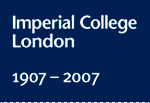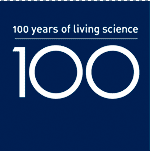Ralph Cornforth
(Physics 1965)
Describes a daring rescue mission from the student lounge in University College
In 1965, while I was an undergraduate student in the Physics Department of Royal College of Science, it was decided that Imperial College should have a mascot. After all, the three constituent colleges had both stealeable mascots and inviolate mascots, so why should Imperial College be without? After much haggling a large, heavy, scale-accurate micrometer was chosen. At the time I was puzzled by this choice, as it seemed more like a mascot suitable for City and Guilds than Imperial College.
It was further decided that a small committee consisting of one representative from each constituent college would be formed, charged with the task of making it happen. I am still not clear what happened to lead me to volunteer to be the Royal College of Science representative. My best defence is temporary insanity and a background of machining acquired from my father. The other representatives were Roger Cross from City and Guilds and Jim McCloud from Royal School of Mines.
With the help of my father, who was an expert machinist, I drew up the drawings of what was going to be a working, large, heavy, scaled-up one-inch micrometer. These drawings were approved and the material acquisition phase started. The design included scale-accurate thread so that the engraving would actually mean something. I decided not to try to make the ratchet on the end of the thimble functional, but it looks good.
I haunted every machine shop in Imperial College until I got to know the great bunch of guys who ran them and together we worked out how to make Mike from the material available in their stores. The barrel and thimble were made from various sizes of heavy steel tubing. The anvil and fake ratchet were made from solid round steel stock. The frame was to be cast from brass.
Jim McCloud arranged for us to buy used brass gun cartridges from a gun club (perhaps the Imperial College gun club, I can't remember). One of the Imperial College 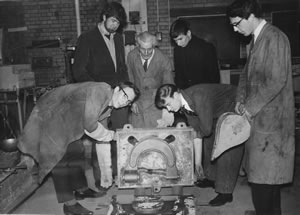 woodshops made the patterns for the casting. The lead carpenter there really knew his stuff when it came to making patterns for castings. Jim then arranged for "Old Mac" in the RSM foundry to make the sand mold halves from the patterns, melt down all the cartridges, and pour the molten brass into the closed mold. We had the great privilege to help Mac with all of this. It was a great moment when we broke the frame out of the mold, but no one had a camera! (Photograph above;
woodshops made the patterns for the casting. The lead carpenter there really knew his stuff when it came to making patterns for castings. Jim then arranged for "Old Mac" in the RSM foundry to make the sand mold halves from the patterns, melt down all the cartridges, and pour the molten brass into the closed mold. We had the great privilege to help Mac with all of this. It was a great moment when we broke the frame out of the mold, but no one had a camera! (Photograph above;
here we are closing the two halves of the sand mold. The hand
bellows is to blow away dry sand that falls into the mold as it closes.
From left to right, back row: Dick Conn, "Old Mac", Paul Ward; front
row: Jim McCloud, Roger Cross, Ralph Cornforth. I don't know the date.)
A freshman volunteered to work on the rough casting to cut off the lumps where the brass was poured in to the mold and to clean up the roughness where the two halves of the mold met.
Meanwhile, I had been machining the steel parts on an old, old lathe in the Mechanical Engineering machine shop. The nice guys in there let me take over this antique full time so I could leave the piece I was working on in the lathe all the time. That way I wouldn't have to set up again each time I grabbed a few minutes between lectures to work on Mike. I managed to machine all the steel parts myself except for the final few thousandths of an inch on the Acme thread of the spindle. The old lathe just wasn't up to it. It had much too much slack in the head bearings and would set up the most awful 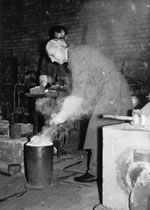 vibrations. The guys in the Civil Engingeering machine shop took pity on me and finished that job for me. They also machined the two holes in the brass frame, one for the anvil and one for the barrel, on their fancy German milling machine. The big deal here was for the two holes to be in exact alignment. The guys in the Civil Engineer machine shop had, by this time, adopted me as one of them and refused to let me fail, as my RCS Motor Club activities (and studies) had begun to get in the way of the real task of making Mike.
vibrations. The guys in the Civil Engingeering machine shop took pity on me and finished that job for me. They also machined the two holes in the brass frame, one for the anvil and one for the barrel, on their fancy German milling machine. The big deal here was for the two holes to be in exact alignment. The guys in the Civil Engineer machine shop had, by this time, adopted me as one of them and refused to let me fail, as my RCS Motor Club activities (and studies) had begun to get in the way of the real task of making Mike.
I had made the barrel from two machined steel tubes. They had been made so that one part was a hard press fit inside the other. The guys in the Civil Engineering workshop used their hydraulic press to force these barrel pieces together. They then engraved the frame, the barrel and the thimble for me on another one of their fancy machines. They also arranged to have all the steel parts chrome plated at no cost to the Union. These guys were amazing - I learned so much from them! (Photograph above;
here "Old Mac" (I don't remember - if I ever knew - his real name) is
removing dross from the top of the melted brass prior to the actual
pour. That's Jim in the background.)
All that was left was for all the parts to be assembled. I did a dry fit in the Mechanical Engineering workshop (my home-away-from-home by now) and I was actually smart enough to take 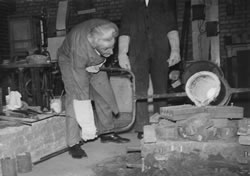 photos. I decided to hold it all together with glue. Araldite donated a special type of epoxy adhesive that would cope with the differential expansion of the brass and steel. The epoxy was applied; everything was jigged into alignment and then carefully clamped. Once the glue had cured, the brass frame was painted. Mike was presented to the next Union meeting with much ceremony. (Photograph on the left; This is the actual moment of pouring the molten brass in the mold.
The odds and ends of heavy stuff on top of the mold was to stop the
top half of the mold lifting as the heavy molten brass filled the space.)
photos. I decided to hold it all together with glue. Araldite donated a special type of epoxy adhesive that would cope with the differential expansion of the brass and steel. The epoxy was applied; everything was jigged into alignment and then carefully clamped. Once the glue had cured, the brass frame was painted. Mike was presented to the next Union meeting with much ceremony. (Photograph on the left; This is the actual moment of pouring the molten brass in the mold.
The odds and ends of heavy stuff on top of the mold was to stop the
top half of the mold lifting as the heavy molten brass filled the space.)
Certain people (or person, who, if I were to name him, would be called Jim McSomething) was very skeptical that the epoxy would hold. He was made to eat his words when he wanted to take Mike apart some time later so the chrome plating could be renewed - and he couldn't persuade the epoxy to budge. They didn't call me Araldite Man for nothing!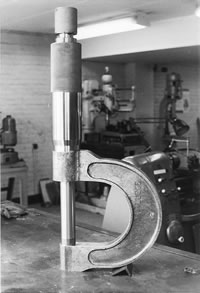
It was decided that Mike should be on permanent display in the Union building and not hidden away like some mascots. The location chosen was the main lounge. I talked the Maintenance Department into letting us do it. I drew up, and the carpenters in the Maintenance Department built for me, a huge wooden form into which they poured concrete to form a plinth to hold Mike on display. The plinth was shaped to fit Mike and included a safe with four locks, built by Jim, which had to be opened to gain access to the release mechanisms for clamps, again built by Jim, which secured Mike to the plinth.
The first college to steal Mike was University College London, but they had to cheat massively to do it. They hid a sneaky scumbag in the Union building after a dance. In the middle of the night, this apology for a human being let other low-lifes into the building via the back door. These disgusting creeps brought with them oxy-acetylene cutting equipment and used it to cut the clamps securing Mike to the plinth. All of this was, of course, completely against universally accepted mascot-stealing rules - but what else can you expect from University College? (Photgraph above;
This was the very first time the machined pieces were test fitted
together. The engraving had been done on the brass frame but not on
the thimble or the barrel. That was the next step followed by the
chrome plating, then final assembly with epoxy adhesive. This was in
the Mechanical Enginering machine shop.)
Eventually we heard that Mike was being held in a room (student lounge?) above a ballroom at University College. They had encased the Mike's frame in a cement block, with a couple of loops of steel rod sticking up through which they had placed poles to allow them to carry the assembly. Once they had it in the room they had cut off the loops, thinking this would mean we couldn't get Mike back to Imperial College. We arrived prepared. We had picks and sledgehammers and were prepared to do whatever it took to get Mike home. The furniture was pushed back and we took turns attacking the block.
After 20 minutes or so of pounding, the room was covered in cement pieces and dust. At this point, a panicked security guard rushed in and said the ceiling of the ballroom 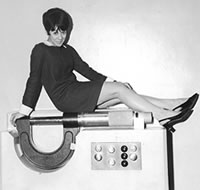 underneath was cracking. We said "Oh, really?" By that point we had knocked all the corners off the cement block and cut the weight down somewhat. We decided to leave and take Mike with us. The smug looks on the faces of the people of questionable ancestry who had stolen Mike told us something was up. They said the lift wasn't working. "No problem", we said, "we'll just bounce Mike and his load of cement down the stairs, one step at a time. We have plenty of ropes and people. Shouldn't take long. It probably won't break EVERY step as we go down 3 floors."
underneath was cracking. We said "Oh, really?" By that point we had knocked all the corners off the cement block and cut the weight down somewhat. We decided to leave and take Mike with us. The smug looks on the faces of the people of questionable ancestry who had stolen Mike told us something was up. They said the lift wasn't working. "No problem", we said, "we'll just bounce Mike and his load of cement down the stairs, one step at a time. We have plenty of ropes and people. Shouldn't take long. It probably won't break EVERY step as we go down 3 floors."
It was a miracle! When we pressed the button the lift was suddenly working! After we got back to Imperial College, Jim McCloud handled Mike's recovery back to mostly pristine condition, including using a hydraulic press to straighten his frame after the brutal treatment he had received in the hands of those terrible people at University College. (Photograph above;
this photo almost defies explanation. Some government agency that
sent newsletters out overseas heard about Mike and wanted to do an
article. They arrived with this model (girls wore real stockings in
those days) and took this photo - it was all a bit surreal! However,
it is the only photo I have of Mike on the plinth that we built. One
can see the clamp round the frame and the bent bar that went round
the ratchet, both of them were set and released from inside the"safe". This was in the ground-floor student lounge, against the
wall that backs up to the main hallway, between the two doors. I am
still amazed that the building maintenance staff let me do this.
They even poured the cement for me.)
I leave it to others to continue Mike's story.
© 2007 Imperial College London
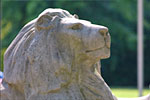
Through the first decade of the twenty-first century the campaign seeks to philanthropically raise £207 million from Imperial’s alumni, staff and friends, and donations from charitable foundations and industry.
Where your support can make a differenceGive now
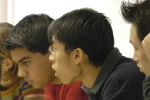
Imperial’s Centenary Year provides an opportunity to recognise and celebrate members of the Imperial community.
View staff and student portraits